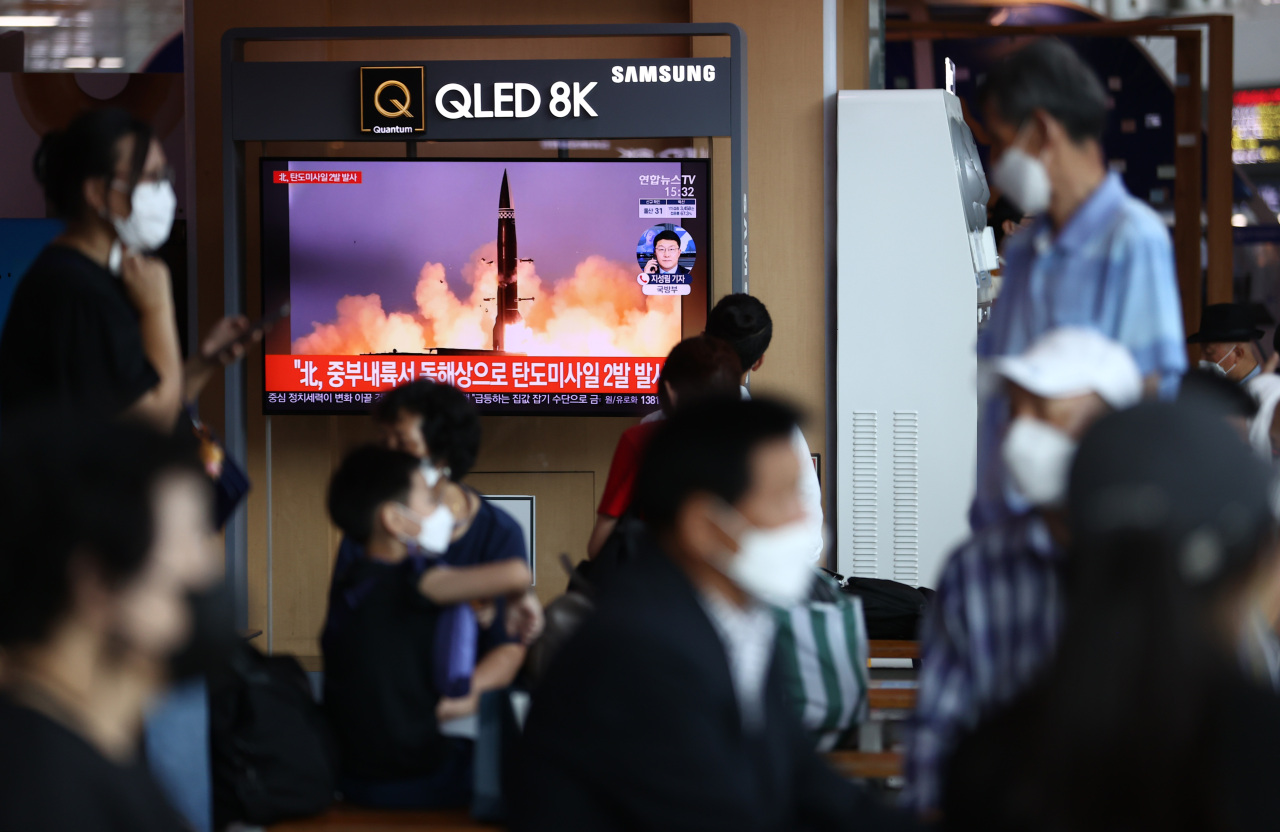 |
Citizens watch a news report on North Korea's missile launch at Seoul Station in central Seoul on Wednesday. (Yonhap) |
North Korea on Wednesday fired a pair of ballistic missiles into the East Sea, following a cruise missile test that took place less than a week ago.
According to South Korea’s Joint Chiefs of Staff, two short-range ballistic missiles were fired from the central county of Yangdok at 12:34 p.m. and 12:39 p.m. and flew around 800 kilometers at a maximum altitude of around 60 kilometers.
“South Korea and US intelligence authorities are analyzing details for additional information,” the JCS said in a statement. “Our military is maintaining a full readiness posture in close cooperation with the US.”
Cheong Wa Dae also said President Moon Jae-in was briefed on the launches immediately and he planned to convene a National Security Council meeting later in the day.
North Korea’s missile tests, a violation of multiple UN Security Council resolutions, prompted condemnations from neighboring countries as well. The latest test is the second ballistic missile launch by the North so far this year.
The US Indo-Pacific Command said North Korea’s missile launches did not pose an immediate threat to US personnel, territory, or allies, but highlighted the destabilizing impact of its illicit weapons program.
In a separate statement, US Forces Korea said, “This activity highlights DPRK’s continuing focus on developing its military program and the threat it poses to Northeast Asian and the international community.”
Japanese Prime Minister Yoshihide Sugal also called the missile launch “simply outrageous,” and said it was a “threat to the peace and security” of the region.
The launches came two days after the North announced it successfully test-fired a new type of long-range cruise missile over the weekend, calling it “a strategic weapon of great significance” to boast its nuclear capability. North Korea is banned from ballistic activity, while cruise missiles are not subject to sanctions.
Observers say the North is seeking to win leverage in the stalled nuclear talks with the US amid a flurry of diplomacy between Seoul and Washington on resuming the almost collapsed diplomacy with the reclusive regime.
During the historic summit talks in Singapore in June 2018, North Korean leader Kim Jung-un suggested his country would move on in phases toward denuclearization in return for sanctions relief, but then-President Donald Trump demanded a quicker, immediate abandonment of all nuclear weapons. Such discrepancies are said to have led to the breakdown of their second summit in Hanoi in February 2019.
With President Joe Biden assuming the post in January, both Seoul and Washington have sent multiple overtures asking to resume talks without preconditions, but Pyongyang’s response has been lukewarm as it calls humanitarian assistance “not essential.”
In the meantime, South Korea on Wednesday succeeded in firing its homegrown submarine-launched ballistic missile for the first time, becoming the eighth and the only non-nuclear country to develop the more advanced missile technology.
 |
President Moon Jae-in inspects the test launch of the nation`s first SLBM at the Agency for Defense Development in Anheung, Gyeonggi Province, on Wednesday. (Cheong Wa Dae) |
Moon, accompanied by his chief security adviser, Suh Hoon, and Defense Minister Suh Wook, inspected the test launch that was held at the Agency for Defense Development in Anheung, Gyeonggi Province, hours after the North’s missile launches.
The new SLBM, code-named Hyunmoo 4-4, is a variant of the Hyunmoo-2B ballistic missile, which could fly up to 500 kilometers and reach anywhere in North Korea. It will go through more tests before being deployed on the Dosan Ahn Chang-ho submarine, the nation’s first 3,000-tone underwater vessel unveiled last month.
“Our enhanced missile power can be a certain deterrent to North Korea’s provocation,” Moon said, stressing that his country had conducted the SLBM test as scheduled, not as a response to the North’s latest provocation.
Unlike conventional land-based missiles, SLBMs are harder to detect as they are launched from submarines for surprise strikes, which is why they are often called a “game changer.”
North Korea has showcased several new types of SLBMs recently and is working to build a new submarine believed to be a 3,000-ton model capable of carrying SLBMs.
Nuclear warheads, among other things, make their SLBMs far more powerful than South Korea’s, but Seoul has a lead in submarine technology and is looking to widen the gap.
The Navy plans to make the Dosan class combat ready as early as August next year and by the late 2020s deploy six submarines in total, each of which could carry up to 10 SLBMs.
By Lee Ji-yoon (
jylee@heraldcorp.com)








![[Today’s K-pop] Blackpink’s Jennie, Lisa invited to Coachella as solo acts](http://res.heraldm.com/phpwas/restmb_idxmake.php?idx=644&simg=/content/image/2024/11/21/20241121050099_0.jpg)
